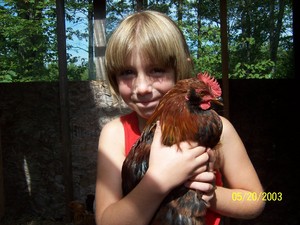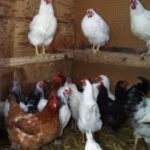The ultimate recession proof food has to be, hands down, the egg. So why do I say that? Well, let’s look into the math. A box of jumbo eggs is around $3 at the supermarket. Out of this box a typical adult will have 2 eggs per meal. That averages out to around .25$ an egg or .50$ a meal. Now comes the fun part. Should you decide to raise your own chickens a flock of 13 will give you around a dozen a day in peak season. That would average out to 365 dozen per year or around 30 dozen a month. Times this by $3 a dozen and you have about $90 worth of eggs a month. A pretty good deal if you consider that a brood of the size illustrated only costs around $40 to maintain every month. That is a savings of $50 per month. So when the rest of the world is paying $3 per dozen or .25$ per egg you are paying a mere $1.33 per dozen or .11$ per egg for jumbo size. Think that this is a win win situation? Well, it gets better!! As an egg sets it looses its taste and nutrition so fresh eggs have more nutrition and tastes hundreds of times better then a store bought egg.
So how do you get started? Well first comes the chicken, in our case anyhow!! If it is early spring, around February or March, head off to your local hardware store or local Agway. These places usually sell chicks, known as layers, in rural areas such as New England. If they don’t supply them, most places know how to acquire them so just ask. First you will be asked to place an order as the chicks will not be available until around or after Easter. This is vital to do as chicks are sent from the farm on a pre-order basis only. Only a few extra chicks are sent in to compensate for DOAs (Dead On Arrival) so get your order in now.
Now you will be asked what kind of chicks you want, layers or meat. You will want layers since these are the chicks equipped to give you what it is you need, eggs. Next you will be asked what breed. This can be tricky. Some breeds are high production but will stop laying and die off more quickly while others are low production and will live and produce longer. To view more then 60 breeds you will want to go to this handy list . Another factor in breeds would be what you prefer. I myself was raised with Rhode Island Reds and New Hampshire Reds, both of which are extremely common for New England farmers and very friendly towards the kids. Both of these come in a reddish color with the New Hampshire Reds being much lighter. In both breeds the eggs are always the same color, brown. Until my daughter was in 3rd grade I had no experience with any other breed. That year she brought home from school a small brood of what is called the Ameraucana. Delighted to try something new I readily welcomed these odd little ladies into my home. Soon I was in for the shock of a lifetime. In the henhouse we started finding blue and green eggs!! Concerned for my sanity I contacted the school. They laughingly filled me in on the fact that these birds, known as Easter Eggers, are known to lay a rainbow of multi-colored eggs. Delighted, I ran to the hardware store and ordered some more. Now I wouldn’t entirely recommend the Ameraucana to everyone as these birds can be aggressive but I would recommend delighting the kids with a few specimens anyhow. While ordering you will also want to consider your family size. For an average family of 6 around 13 chickens is ideal. However, always order more then you need, say 15, because the hardware store cannot guarantee you will get all females in your brood. I usually get about 1 rooster out of every 7 chickens that I purchase.
Now that you have your order in it is time to make a home for your arriving brood. For a flock of around 13 you will need a 10×10 chicken house. Construct this from 2x4s and plywood sheathing just as you would a regular house. See this article to get ideas on how to build basic wall structures. For the floor use a water-proof membrane, such as Detra, to keep urine, water, feces and rotted food from penetrating the floorboards. Make sure you butt your sheathing tightly together so as to leave no cracks whatsoever in the floors and walls. Use a wooden storm door for the front. This will allow you to have screens in the summer and glass in the winter. On a few walls place some old wooden windows that have screens. Now use a staple gun to securely attach metal hardware cloth over each and every window on the outside of the house. This will allow you to open the windows from the inside for the summer without allowing in dangerous fisher cats or weasels. Secure the same hardware cloth to the outside of the storm door. Whatever you do, don’t use chicken wire for this application as weasels and fisher cats can crawl through the widely spaced holes and into the house. On the outside of the house staple Tyvek or Tarpaper. This will help keep the cold out in winter. Now, for the roof. Here you will want to use the see through fiberglass panels that you see on cheesy garage roofs throughout suburbia. See through is important as natural sunlight increases egg production. Attach the panels by running strapping across the coup from wall to wall every 16. Using roof screws attach the roofing to the strapping.
Now that your basic structure is up and secure from varmints, you will want to add some finishing touches for ascetics and for comfort of your brood. Run a heavy duty power cord from your house, or have an electrician install a 4 gang GFI outlet up out of the chicken’s reach. If you ran a cord, plug this into a power strip adhered to a place in the coup where it is hard for the chickens to get to. If you had an electrician in then you will want him to also install a light fixture within the coup for easy night time feeding and watering. Now that you have electricity pick a spot within the coup that would be great for sleeping. Here you will want to put your heat lamp with the plug brought up and away so the chickens cannot pull it out. Just be sure to keep the heat lamp far enough from any burnable products as possible. They are known to cause serious fires. Hanging it a good 3′ from the wall, off of the roof strapping and down a good 3′ from the roof would be perfect. On the other side of the coup you will want to set up an eating spot. For this, in colder climates, you will want a few heated water dishes and two large feeding dishes. Don’t plug in the water dishes unless they actually contain water. In the remaining spaces you will want to set up a nesting area and a roosting area. For the nesting area use wooden boxes about 2’x2′ in size filled with straw or wood chips. Three to four of these will be great for a brood of 13 chickens. Inside of each place a plastic Easter egg. This will stimulate your brood into laying in no time. On the wall, hang wooden curtain rods that come out a good 6-12″ from the wall when hung. And no, I haven’t been hitting the eggnog!! Curtain rods are perfect for roosting on. On the floor spread some hay or some wood chips. Outside you can put up some siding if you wish as well as some window boxes and the such. Now you are ready to start the fun and fine art of chicken farming in earnest.
Once your chicks arrive place them in a nesting box under the heat lamp. This can be placed in the house or in the coup itself depending on the outdoor temperatures when your chicks arrive. We usually put ours on the kitchen counter with the heat lamp placed far away from all burnable items. Just be careful not to get the heat lamp too close to the chicks unless you like chicken fricassee!! A good 2′ away is perfect. During this part of their lives a small dish of starter feed and a small dish of water, plenty of warmth and some wood chips are all they need to be happy. So how do you know when they are ready to go free in the coup? Don’t worry, they will tell you themselves. And no, Doc doesn’t have talking chickens!! What will happen is that they will begin to fly about. I know some of you will say, “Chickens cannot fly!!” Truth is that they do fly but not very well. A few feet is about it but it is enough to get them into trouble non-the-less. We once spent an entire night looking through kitchen cupboards for chickens that had literally flown the coup!! On another occasion I was cleaning up the kitchen floor when I discovered a chicken roosting on my back!! When this happens it is time for them to start their new residency in the chicken coup.
Now it is time to do a little soul searching and complete another trip to the store. Once your chickens are ready for the coup they will need to start on what is called layer pellets and oyster shells. This combination will gear up their bodies to produce for you some incredible looking eggs. For the soul searching you will need to consider if you want to clip your chicken’s wings and beaks. I personally find this cruel and unusual behavior but some farmers feel that it keeps them safe from each others constant pecking. I will admit that I have a few naked chickens in the coup because of our bully Ameraucana who pecks off the feathers of a select batch of my ladies. However, when a fisher cat and a raccoon got into the coup one year, our chickens were able to fend for themselves with their sharp beaks and ability to fly up out of harm’s way. If you do decide to have your ladies fixed bring them to your veterinarian to be sure you are getting it properly done.
So now comes the waiting game. Typically a chick born in April will begin egg production around October. However, there are exceptions to the rule so be patient. Placing plastic Easter eggs in the layer boxes will help give your ladies the idea of what to do with the boxes. However, nature is really the only determining factor when it comes to egg production. When your chicks do begin to produce you will notice that the eggs will be small at first. Don’t worry about this. As the chicken grows the eggs will too. Provided with proper nutrition and plenty of oyster shells your chickens will eventually be producing jumbo sized eggs. Speaking of nutrition, chickens will eat anything so feel free to dump your kitchen scraps into the spare bowl in the coup. Not only do tidbits of meat, veggies and fruits taste good to your ladies but they also add even more nutrition to their diet. If you feel that you would like to add even more fun foods to their diets, check out your local stores and restaurants. Some of these are more then happy to give you second rate goods for free or reduced cost. Nissen’s gives out huge bags of breads for only $2 a bag while our local market gives us giant banana boxes full of all sorts of veggies and fruits for free. This will reduce your grain needs without compromising your ladies nutrition. That will ultimately make your feeding costs go down and your egg profits go up.
Now you are officially a gentleman or lady chicken farmer as the case may be. It is and was that simple. However, if you ever have any questions or need any help feel free to give Doc a call. And also be sure to tell me some of your funny chicken stories. I know you will have some of your own soon!!








